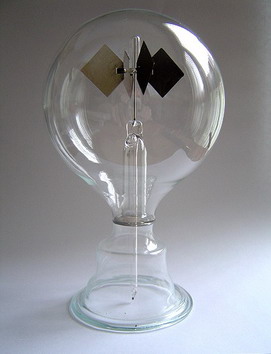Physics
Theory of Accretion Discs
Willy Kley †, Anna Penzlin, Thomas Rometsch, Lucas Jordan, Hugo Audiffren, Will Béthune, Christoph Schäfer

Hubble view of the Orion nebula showing five young
stars of which four are surrounded by protoplanetary discs (Courtesy: NASA)
Our research focusses on the physical structure and dynamics of accretion discs. Examples include circumstellar discs around T-Tauri stars, consisting mainly of gas and also a small amount of interstellar dust. In accretion discs the gas rotates with nearly Keplerian velocity around the host star, spirals slowly inwards and is accreted onto the central star. In our group we study various aspects of accretion disc physics.
- Turbulence
It causes the gas to lose energy and angular momentum, and therefore drives the accretion process. The physical source of the turbulence is still unclear, but magnetorotational instability (MRI) is the most likely mechanism. - Thermodynamics
It governs the thermal structure of the disc. The temperature in the disc follows from an equilibrium between turbulent dissipation, pdV-work and radiative cooling. It determines the disc thickness in the vertical direction at a given location. - Self-gravity
It plays an important role in very massive discs. Depending on the efficiency of cooling, gravitational instabilities can occur and cause the disc to develop spiral arms or even to fragment. - Companion stars
A companion can influence the evolution of the disc by tidal forces and may cause the disc to become eccentric.
Planet Formation
Willy Kley †, Anna Penzlin, Thomas Rometsch, Lucas Jordan, Hugo Audiffren, Christoph Burger, Rafael Sfair, Christoph Schäfer

Simulated image of a self-gravitating disc undergoing fragmentation
Planet formation has been an area which has been studied in great detail with respect to the Solar System. The discovery of hundreds of extra-solar planets since the mid-1990s has put the field into a much larger context. A revision of the major aspects of classical planet formation theory is required. In our group we study various aspects of planet formation within the sequential accretion and gravitational instability scenario.
- Dust properties
In the very beginning, planetesimal growth depends strongly on the material properties of the constituent dust particles. Using laboratory data for dusty material we perform ab initio simulations to calculate the continuum properties of dust agglomerates. - Early dust growth
The initial particle growth in the protoplanetary disc requires sticking upon individual collisions. Present models encounter great difficulties in growing particles beyond a decimeter due to destructive collisions. Using new data and methods we perform simulations to calculate the statistical outcome of collisions. - Migration
Planet-disc interactions cause a change in the orbital elements of embedded planets. For smaller planets of a few earth masses, the theoretically obtained migration rates are much too fast to match the observations. We perform detailed models of fully radiative discs with embedded planets to study this important phase. - Gravitational Instability
An alternative formation scenario for planet formation, at least a very large distances from the star, is provided through direct fragmentation of an initially unstable massive protoplanetary disc. We perform simulations to understand the efficiacy of such a process. - Planets in binary stars
Interestingly, a few dozen planets have been discovered in binary stars systems. As the dynamical action of a companion star perturbs the disc significantly, the planet formation process is more difficult. We follow the dynamics of such discs and study the impact on the formation process.
Astrophysical Jets

Hubble view of the Protostellar Jet HH 47
(Courtesy: NASA)
Astrophysical jets are ubiquitous, occurring in a variety of objects on very different size and mass scales. They can be produced by pre-main sequence stars in young stellar objects, by post-AGB stars in pre-planetary and planetary nebulae, by white dwarfs in supersoft X-ray sources and symbiotic stars, by neutron stars in X-ray binaries, by stellar black holes in black hole X-ray binaries and by supermassive black holes in the case of active galactic nuclei. However, there are still many open questions.
- The propagation of jets
How does the jet travel through the interstellar/intergalactic medium? We model the kinematics of jets and their sub-structure (e.g. knots), the emission from radiative shocks in jets and the morphology of jets. - The formation of jets
Jets are formed by large-scale magnetic fields threading an underlying accretion disc. We solve the equations of magnetohydrodynamics (MHD) numerically and investigate analytical self-similar solutions. - The interplay between accretion and jet ejection
How does the formation of jets depend on accretion states? Why are jets formed in one class of objects, but not in another? What are neccessary conditions for jet formation?
We investigate jets with analytical models, numerical simulations and observations with several space telescopes.
Individual Projects
Thermal creep in lightmills
Willy Kley, Daniela Skoropad, David Wharam (PIT)

A lightmill (Courtesy: Wikipedia)
In the so-called MEMS (micro-electro-mechanical-systems) we see effects that also occur in rarefied gases. To get a better understanding of these effects, we examine the behaviour of lightmills. A lightmill consists of four vanes, which have a shiny and a blackened side. Under illumination, the blackended side heats up and the mill starts to rotate in the direction of shiny sides. This rotation only occurs in a small pressure regime, typically at pressures of around 1 Pa. At such low presures collisions between particles are scarce and therefore several boundary effects have to be taken into account:
- Thermal creep
In case of a thermal gradient, the gas creeps from cold to hot. This is the main cause for the rotation of the lightmill. - Temperature jump
On average, the gas at the wall has a lower temperature than the wall since particles coming from the surface and particles moving in other directions have not had the chance to collide often enough. - Velocity slip
The gas slips over the surface due to the rarefaction of the gas.
Numerical results are compared with experiments at PIT.
